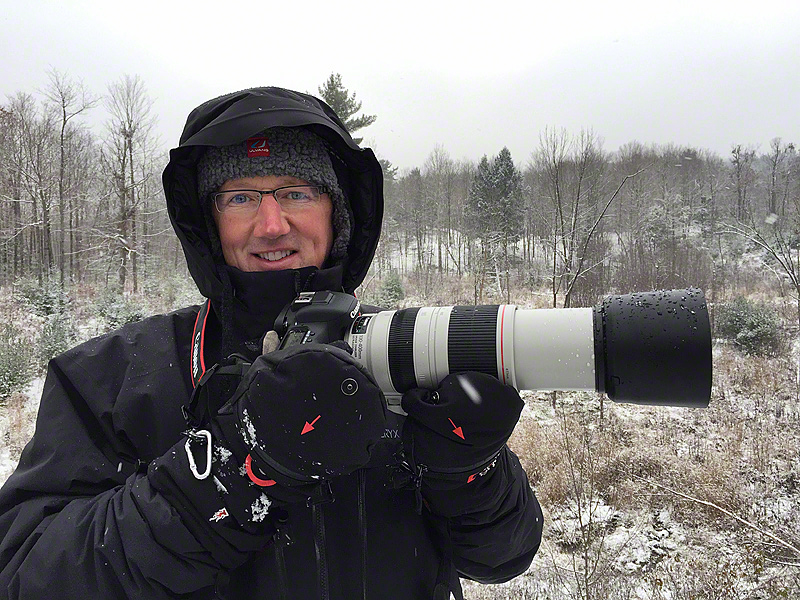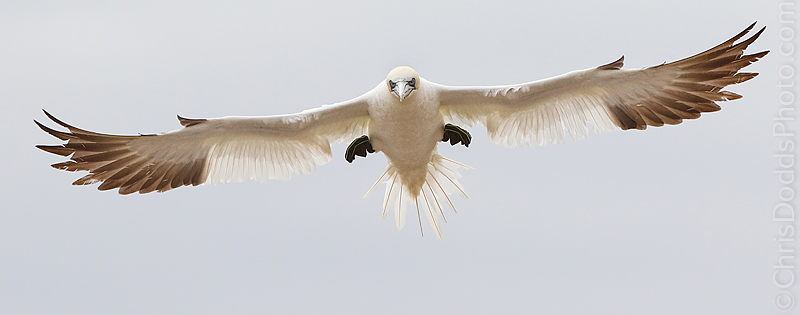 My friends at Canon Canada have done it again; another box with a prototype inside arrived, this time it was the new, and much anticipated, Canon EF 100-400mm f/4.5-5.6L IS II USM lens. I have an "MT" sample, which basically means that it is a pre-production sample and I can't share images from this lens. I was granted permission to post a picture of the lens, so here I am in my favourite weather conditions, with the lens on a newly released EOS 7D mark II; truly a killer, and "must have", wildlife imaging combination! (Image courtesy and copyright Julie Morrison - Thank-you!)
My friends at Canon Canada have done it again; another box with a prototype inside arrived, this time it was the new, and much anticipated, Canon EF 100-400mm f/4.5-5.6L IS II USM lens. I have an "MT" sample, which basically means that it is a pre-production sample and I can't share images from this lens. I was granted permission to post a picture of the lens, so here I am in my favourite weather conditions, with the lens on a newly released EOS 7D mark II; truly a killer, and "must have", wildlife imaging combination! (Image courtesy and copyright Julie Morrison - Thank-you!)
Despite the continual debate about it's consistent sharpness, the original Canon EF 100-400mm f/4.5-5.6L IS USM lens was almost always mounted on a second camera body and slung over my shoulder for nearly a decade. The copy I had was consistently sharp and produced many "portfolio" images, which continue to sell for publication and as prints. I see history repeating itself again, as I anticipate having the new Canon EF 100-400mm f/4.5-5.6L IS II USM lens paired with the new Canon EOS 7D mark II slung over my shoulder while out with my tripod-mounted super-telephoto lens and Canon EOS 1DX in the future.
First impressions: The lens features a completely new design with the old push-pull to zoom lens barrel replaced by a much more weather resistant and user friendly turn to zoom variable torque twist ring. The new lens collar features an easy to remove lens foot and the lens is adorned by a new lens hood with a push button lock release and a sliding window to accommodate filter adjustments (mount the window on the bottom of the lens in wet or snowy weather to keep the front element clean and dry). No detail was over-looked by the Canon engineers when redesigning this beast; it even includes an improved pinch-lock style 77mm lens cap. It is a little heavier than its predecessor, but the improvements to design, image quality and weather sealing are, in my opinion, worth every ounce....and I did get to test the weather sealing while out in the wet snow for an extended shoot as seen in the image above (but let's not tell my friends at Canon what I do to their prototypes - smile). It's even more of a beast if you install a Canon Extender EF1.4X III between the lens and 1.6X crop factor camera (like the 7D mark II); Yes, it still auto-focuses and offers an effective focal length of 224-896mm! Image quality is still impressive with a Canon Extender EF2X III, but the lens needs to be manually focused at a mind-blowing 1280mm equivalent.
Less apparent new features are the lens now "features one fluorite and one super UD element to help provide impressive contrast and resolution with reduced chromatic aberration across the entire zoom range. Canon’s new Air Sphere Coating (ASC) helps significantly reduce backlit flaring and ghosting, while fluorine coatings on the front and rear lens surfaces help lessen smears and fingerprints. A 9-blade circular aperture renders beautiful, soft backgrounds, and a 3 mode (standard, panning and exposure only) Optical Image Stabilizer provides up to 4 steps* of image correction." - Canon product page.
Auto-focus speed and accuracy are impressive, with zippy performance only usually expected in the most expensive optics. I haven't tested the lens for birds in flight yet, but my initial impressions are that AF acquisition time and speed are remarkably good. As I discovered way back in 2011 while testing the Canon EF70-300mmL IS USM, the new optics and coatings improve resolution and contrast, which greatly improve the already impressive new auto-focus systems in the latest Canon cameras. The minimum focusing distance has been reduced to only 3.2 feet (my test unit focuses much closer than that), making it a fantastic walk around lens for details in nature too!
As always, I don't spend my time looking at specifications or MTF charts, but I do closely examine the images and evaluate image quality for my "real life" use; big prints. The results are impressive! While important to note that I have based this mini-review on a pre-production unit, it is unlikely that image quality will change with a production model; It would be hard to make it better.
In conclusion, if you are looking for an incredibly versatile wildlife, nature, birds-in-flight, sports and action set-up that won't break your back or bank account, then the new Canon EF 100-400mm f/4.5-5.6L IS II USM lens, paired with the new Canon EOS 7D mark II and a Canon Extender EF1.4X III truly are a wildlife photographer's new secret weapon! It's a relatively compact, packable and manageable kit that I won't be caught without!
From the Canon product page:
"The EF 100-400mm f/4.5-5.6L IS II USM lens delivers a superb combination of cutting-edge performance, compact construction and brilliant resolving power that’s great for sports and wildlife photography. The lens features one fluorite and one super UD element to help provide impressive contrast and resolution with reduced chromatic aberration across the entire zoom range. Canon’s new Air Sphere Coating (ASC) helps significantly reduce backlit flaring and ghosting, while fluorine coatings on the front and rear lens surfaces help lessen smears and fingerprints. A 9-blade circular aperture renders beautiful, soft backgrounds, and a 3 mode (standard, panning and exposure only) Optical Image Stabilizer provides up to 4 steps* of image correction. The new inner focusing AF system helps ensure fast and accurate focus down to 3.2 ft. with a .31x maximum magnification. Usability enhancements include a rotation-type zoom ring with adjustable zoom torque for more precise, customizable zoom performance, a redesigned tripod mount that can be attached and detached without removing the lens from the camera, and an all-new lens hood with a side window that makes it simple to adjust specialty filters-like polarizers-without the need to remove the hood. Ruggedly constructed with advanced dust and water sealing for durability in a range of environments, the EF 100-400mm f/4.5-5.6L IS II USM lens is a stellar performer with refined controls for a wide variety of situations."
